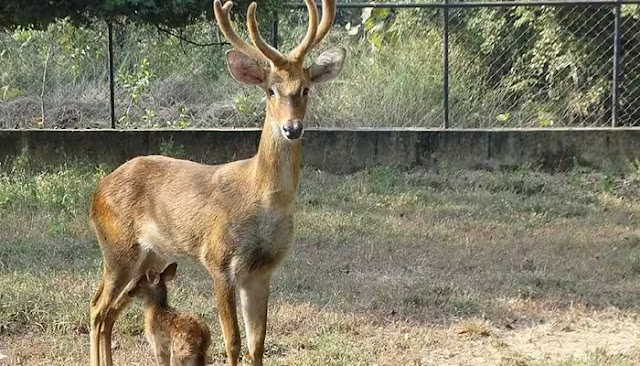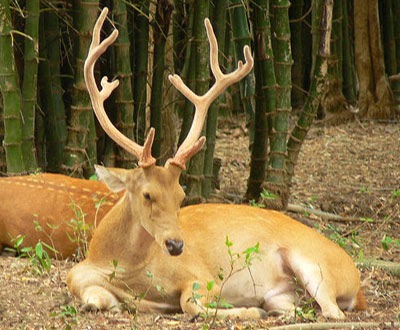मणिपुर का राज्य पशु "संगाई"
वैज्ञानिक नाम: सेर्वुस एल्डी
"शंघाई हिरण"
मणिपुर का राज्य पशु है। इसकी गतिविधियों के कारण इसे 'डांसिंग डिअर' के नाम से भी जाना जाता है। विशेष रूप से यह मणिपुर के "केबुल लामजाओ
राष्ट्रीय उद्यान" में निवास करता है। केबुल लामजाओ विश्व का एकमात्र तैरता
हुआ राष्ट्रीय उद्यान है, जो कि मणिपुर में
स्थित "लोकटक झील" पर अवस्थित है और इसी भौगोलिक क्षेत्र में "शंघाई हिरन" भी पाया जाता है।
मणिपुर के नाचने वाले हिरण या भौंह-एंटीलर्ड हिरण के रूप में भी जाना जाता है, संगाई एक अद्वितीय हिरण है। यह जानवर एक मध्यम आकार का हिरण है, जिसके विशिष्ट सींग होते हैं, जिसकी लंबाई 100 -110 सेमी होती है और भौंहें बहुत लंबी होती हैं, जो मुख्य बीम बनाती हैं। उनके पास लाल भूरे से भूरे रंग का कोट, गहरे भूरे रंग की काली नाक, होंठ और मुंह हैं। इन हिरणों के नर की ऊंचाई 115-130 सेमी होती है। जबकि, महिलाओं की ऊंचाई मूल रूप से 90-100 सेमी मापी जाती है। नर का वजन 90-125 किलोग्राम होता है, जबकि मादा का वजन 60-80 किलोग्राम होता है। यह एक मध्यम आकार का हिरण है जिसमें असामान्य सींग (हिरण के सिर पर शाखाओं वाले सींग) और लंबी भौंहें होती हैं, यही कारण है कि इसे भौंह-मृग हिरण के रूप में भी जाना जाता है। मणिपुर में लगभग 200 संगाई हैं।
संगाई विभिन्न प्रकार के पानी में रहने वाले पौधों, घासों, जड़ी-बूटियों के पौधों और अंकुरों को खाता है - ज़िज़ानिया लैटिफोलिया, सैकरम मुंजा, एस बेंगालेंसिस, एरियनथस प्रोसेरस, ई रेवर्नने, आदि, जानवर के पसंदीदा भोजन पौधे हैं।
वनस्पतियों का तैरता हुआ बायोमास, जो घास के मैदान (घास के मैदान का एक टुकड़ा) बनाता है, जिसे स्थानीय तौर पर 'फुमदी' कहा जाता है, संगाई के निवास का प्रमुख कारण है। लेकिन, लगातार बाढ़ और मानव निर्मित जलाशय के कारण इन घास के मैदानों का निवास स्थान लगातार ख़राब हो रहा है। प्रदूषण के कारण इन जलाशयों से उपभोग किए जाने वाले पानी की गुणवत्ता धीरे-धीरे कम हो रही है। इसके अलावा, इसके निवास स्थान को प्रभावित करने वाले अन्य खतरे बीमारियों से संबंधित हैं - अवैध शिकार, अंतःप्रजनन अवसाद, अन्य। जंगल में संगाई का अधिकतम जीवनकाल लगभग 10 वर्ष का होता है।
विश्व वन्यजीव कोष (डब्ल्यूडब्ल्यूएफ) के अनुसार, संगाई को 1950 तक लगभग विलुप्त माना गया था, 1953 में, राष्ट्रीय उद्यान में छह हिरणों को देखा गया था। तब से, मणिपुर राज्य ने कुछ प्रमुख पहलों के साथ इस प्रजाति की रक्षा की है।
डब्ल्यूडब्ल्यूएफ-इंडिया ने पहले मणिपुर वन विभाग और भारतीय वन्यजीव संस्थान के साथ बैठकें की हैं, और संगाई के संरक्षण परिदृश्य के संबंध में जमीनी अध्ययन के लिए केइबुल लामजाओ राष्ट्रीय उद्यान में प्रतिनिधिमंडल भेजा है। मूल्यांकन के आधार पर, डब्ल्यूडब्ल्यूएफ-इंडिया ने सरकार को कुछ सिफारिशें कीं। संगाई के संरक्षण के लिए मणिपुर की ओर से - जिसमें कुछ जानवरों को दूसरे घर में स्थानांतरित करना भी शामिल है।
इस बीच, मणिपुर के वन विभाग के अनुसार, इसके आवास की पहली जनगणना 1975 में की गई थी, जिसमें केवल 14 प्रमुखों की गणना की गई थी। दुनिया में लुप्तप्राय हिरण प्रजातियों में से एक, यह अब केवल मणिपुर के केबुल लामजाओ राष्ट्रीय उद्यान में उपलब्ध है। इसे अंतर्राष्ट्रीय प्रकृति संरक्षण संघ (IUCN) के वन्यजीव (संरक्षण) अधिनियम, 1972 की अनुसूची -1 में 'लुप्तप्राय' प्रजाति के रूप में चिह्नित किया गया है।
English Translate
State Animal of Manipur "Sangai"
Scientific Name: Cervus aldi
"Shanghai Deer" is the state animal of Manipur. Due to its activities it is also known as 'dancing deer'. Specifically it resides in "Kebul Lamjao National Park" of Manipur. Kebul Lamjao is the only floating national park in the world, which is situated on the "Loktak Lake" located in Manipur and in the same geographical area the "Shanghai Deer" is also found. Keibul Lamjao, located in the south-eastern part of Loktak Lake, is the largest natural fresh water lake in north-east India.
Also known as the dancing deer of Manipur or the brow-antlered deer, the Sangai is a unique deer. This animal is a medium-sized deer with distinctive antlers, measuring 100 -110 cm in length and very long eyebrows, which form the main beam. They have a reddish brown to brown coat, dark brown to black nose, lips and mouth. The height of the males of these deer is 115-130 cm. Whereas, the height of women is basically measured at 90-100 cm. The weight of the male is 90-125 kg, while that of the female is 60-80 kg. It is a medium-sized deer with unusual antlers (branching antlers on the deer's head) and long eyebrows, which is why it is also known as the brow-antlered deer. There are about 200 Sangais in Manipur.
Sangai eats a variety of water-dwelling plants, grasses, herbaceous plants and shoots – Zizania latifolia, Saccharum munja, S. bengalensis, Erianthus procerus, E. revernae, etc., are the favorite food plants of the animal.
The floating biomass of vegetation, which forms a meadow (a patch of grassland), locally called 'phumdi', is the major source of Sangai habitat. But, the habitat of these grasslands is continuously getting degraded due to frequent floods and man-made reservoirs. The quality of water consumed from these reservoirs is gradually decreasing due to pollution. Furthermore, other threats affecting its habitat are related to diseases – poaching, inbreeding depression, among others. The maximum lifespan of a sangai in the wild is about 10 years.
According to the World Wildlife Fund (WWF), the Sangai was considered nearly extinct by 1950. In 1953, six deer were sighted in the national park. Since then, the state of Manipur has protected this species with some major initiatives.
WWF-India has previously held meetings with the Manipur Forest Department and the Wildlife Institute of India, and sent delegations to Keibul Lamjao National Park for on-the-ground studies regarding the conservation scenario of Sangai. Based on the assessment, WWF-India made some recommendations to the government. from Manipur for the conservation of Sangai – which also includes relocating some animals to another home.
Meanwhile, according to the Manipur Forest Department, the first census of its habitat conducted in 1975 counted only 14 heads. One of the endangered deer species in the world, it is now available only in Keibul Lamjao National Park in Manipur. It is marked as an 'endangered' species in Schedule-I of the Wildlife (Protection) Act, 1972 of the International Union for Conservation of Nature (IUCN).
The Forest Department took the initiative in 1975 and notified Keibul Lamjao National Park in 1977. With intensive in-situ conservation efforts by the department, the population of Sangai has increased substantially. As of 2016 land census, the population of Sangai has reached 260.
भारतीय राज्य के राजकीय पशुओं की सूची || List of State Animals of India ||







Vibrant and interesting 👌🏻
ReplyDeleteNice Information 👌🏻😊
ReplyDeleteNice information
ReplyDeleteअच्छी जानकारी
ReplyDeleteati sundar
ReplyDelete🙏🙏💐💐शुभप्रभात 🕉️
ReplyDelete🚩🚩जय जय सियाराम 🚩🚩
👍👍👍बहुत अच्छी जानकारी शेयर करने के लिए आप का बहुत बहुत धन्यवाद 💐💐
Beautiful.
ReplyDeleteNice
ReplyDelete